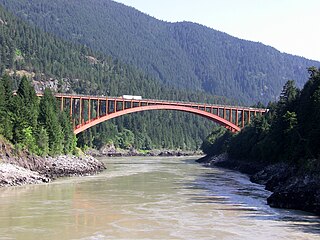
Hazelton is a village located at the junction of the Bulkley and Skeena Rivers in northern British Columbia, Canada. It was founded in 1866 and has a population of 305 (2011). The nearby larger community of New Hazelton is the northernmost point of the Yellowhead Highway, a major interprovincial highway which runs from Prince Rupert, British Columbia to Portage la Prairie, Manitoba.
Gitxsan Nation is one of Canada's First Nations and is a name used when referring to the Office of the Hereditary Chiefs of the Gitxsan, which is the formal governing body of the Gitxsan people. Their territories are located in the Skeena Watershed of British Columbia, Canada, covering 35,016 square kilometers of land.

Andrew George Jr. is a Canadian chef and writer.

Delgamuukw v British Columbia, [1997] 3 SCR 1010, also known as Delgamuukw v The Queen, is a ruling by the Supreme Court of Canada that contains its first comprehensive account of Aboriginal title in Canada. The Gitxsan and Wet'suwet'en peoples claimed Aboriginal title and jurisdiction over 58,000 square kilometres in northwest British Columbia. The plaintiffs lost the case at trial, but the Supreme Court of Canada ordered a new trial because of deficiencies relating to the pleadings and treatment of evidence. In this decision, the Court went on to describe the "nature and scope" of the protection given to Aboriginal title under section 35 of the Constitution Act, 1982, defined how a claimant can prove Aboriginal title, and clarified how the justification test from R v Sparrow applies when Aboriginal title is infringed. The decision is also important for its treatment of oral testimony as evidence of historic occupation.

Alexandra Bridge Provincial Park is a provincial park in British Columbia, Canada, located in the Fraser Canyon approximately two kilometres north of Spuzzum and 40 kilometres (25 mi) north of Hope.
Driftwood Canyon Provincial Park is a provincial park in British Columbia, Canada. Driftwood Canyon Provincial Park covers 23 ha of the Bulkley River Valley, on the east side of Driftwood Creek, a tributary of the Bulkley River, 10 km northeast of the town of Smithers. The park is accessible from Driftwood Road from Provincial Highway 16. It was created in 1967 by the donation of the land by the late Gordon Harvey (1913–1976) to protect fossil beds on the east side of Driftwood Creek. The beds were discovered around the beginning of the 20th century. The park lands are part of the asserted traditional territory of the Wet'suwet'en First Nation.
François Lake Provincial Park is a provincial park in British Columbia, Canada, located at the east end of Francois Lake. Total park area is 7,214 hectares. It is about 12 km off BC Highway 16, southwest of the town of Fraser Lake. There is no potable water at the site so campers should bring their own.
The Wetʼsuwetʼen First Nation is a First Nations band located outside of the village of Burns Lake, British Columbia, Canada. It was formerly known as the Broman Lake Indian Band and is still usually referred to as Broman Lake although this is no longer its official name. Its members speak the Wetʼsuwetʼen dialect of Babine-Witsuwitʼen, a Northern Athabaskan language. The main community is on Palling Indian Reserve No. 1.
Netalzul Meadows Provincial Park is a provincial park in British Columbia, Canada. It is located in the Harold-Price watershed, about 50 km north of Smithers. The park consists of an unusual wet meadow complex, as well as a spectacular waterfall and rare plant species.

The Bulkley Valley is located in the northwest Central Interior of British Columbia, Canada.

Witset is a Wet'suwet'en village in Central British Columbia, Canada on the west side of the Bulkley River on Coryatsaqua (Moricetown) Indian Reserve No. 2, and on Moricetown Indian Reserve No.1. The current village was built during the early 1900s. Evidence of inhabitants date back to around 5,500 years ago.

Gitxsan are an indigenous people of Canada whose home territory comprises most of the area known as the Skeena Country in English. Gitksan territory encompasses approximately 53,000 square kilometres (20,000 sq mi) of land, from the basin of the upper Skeena River from about Legate Creek to the Skeena's headwaters and its surrounding tributaries. Part of the Tsimshianic language group, their culture is considered to be part of the civilization of the Pacific Northwest Coast, although their territory lies in the Interior rather than on the Coast. They were at one time also known as the Interior Tsimshian, a term which also included the Nisga'a, the Gitxsan's neighbours to the north. Their neighbours to the west are the Tsimshian while to the east the Wet'suwet'en, an Athapaskan people, with whom they have a long and deep relationship and shared political and cultural community.

New Hazelton is a district municipality on Highway 16 in northwest British Columbia, Canada. It is situated 133 km (83 mi) northeast of Terrace and 68 km (42 mi) northwest of Smithers and in 2016 had a population of 580 people, a decrease of 12.9% comparing to 2011. New Hazelton is one of the "Three Hazeltons", the other two being the original "Old" Hazelton located 4 miles to the northwest very near to the confluence of the Skeena and Bulkley Rivers and South Hazelton, 3 miles to the west.

The Alexandra Bridge is a steel arch-span bridge crossing the Fraser River on the north side of Spuzzum, British Columbia and 39 km from Hope, on the Trans-Canada Highway in the Fraser Canyon region of southern British Columbia, Canada. It was constructed between 1960 and 1964 and is the third structure in the area named the Alexandra Bridge.
The Hagwilget Village First Nation is a First Nations band government of the Wet'suwet'en subgroup of the Dakelh (Carrier) people, located at Hagwilget, British Columbia, Canada, which is just east of Hazelton, British Columbia. The band is one of the 13 member governments of the Hereditary Chiefs of the Wet'suwet'en, which functions as a tribal council in alliance with the 35 members of the Hereditary Chiefs of the Gitxsan.
Gene Anne Joseph is a Wet'suwet'en Nadleh'dena First Nations librarian from Hagwilget, British Columbia. She was the founding librarian of the Xwi7xwa Library at the University of British Columbia and the first librarian of First Nations descent in British Columbia. In 2018, she received an honorary Doctor of Laws from Vancouver Island University. The British Columbia Library Association, the First Nations Interest Group, and the University of British Columbia First Nations House of Learning created an endowed scholarship in her name.















